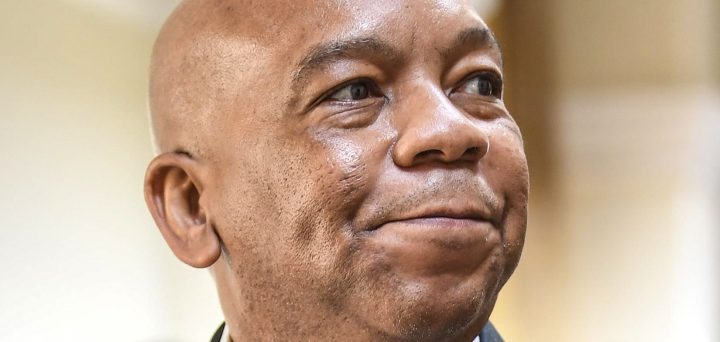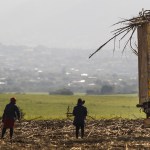POWER CRISIS
Mega bid window to be released to market in June — but SA’s big challenge is grid capacity, says electricity minister

‘You can run as many bid windows as you want, but if you don’t have grid access there’s no value,’ said Minister of Electricity Kgosientsho Ramokgopa.
Last week, Minister of Electricity Kgosientsho Ramokgopa unofficially announced plans for a “mega bid window” of more than 15,000 megawatts (15 gigawatts) of additional renewables.
During an interview with Daily Maverick at his new office at the Union Buildings in Pretoria, Ramokgopa said while it’s planned to have the bid open before the end of June, opening it is the easy part — the challenge is grid capacity.
“You can run as many bid windows as you want, but if you don’t have grid access there’s no value,” said Ramokgopa.
To date, there have been six bid windows released as part of the Renewable Energy Independent Power Producer Procurement Programme (REIPPPP), four of which have projects connected to the grid, totalling about 6,000MW (6GW) of installed capacity — only 5% of SA’s energy supply.
According to the 2019 Integrated Resource Plan, about 30GW of new generation capacity, most of which consists of renewables, must be added to the grid by 2030.
Read more in Daily Maverick: How the ANC’s years-long delays on renewables plunged SA into darkness and scuppered plan to end blackouts
Ramokgopa said this 15GW window could be called Bid Window 7 or “a rolling bid window — essentially, when it opens it doesn’t close”.
Ramokgopa said the National Energy Crisis Committee had approved the rolling bid window, which brings about desperately needed generation capacity, the size and scale of which abate the “genuine concerns that we are not committed to decarbonisation”.
‘Good and bad’
Wikus Kruger, a research fellow who deals with power sector investment in Africa at UCT’s Power Futures Lab, told Daily Maverick, “The plan to procure 15GW is, in principle, both good and bad.
“The good… we need a lot of new capacity really quickly. The bad is, if you run an auction for that round, you will not get any competition and prices will be really high or higher than they need to be.”
Kruger explained that if there’s so much capacity up for grabs in a bid window, there’s no competitive pricing because all the bidders know they will win — which is what happened in the first bid window, where there weren’t enough projects ready for the amount of energy on offer, resulting in bids being close to the ceiling price, which was very expensive.
“Ideally, you’d want to have double that amount of capacity being bid in the round to get competitive pressure,” said Kruger.
He said that before a company bids to be part of the REIPPPP, it has to have secured land (bought or leased), a firm estimate of whether an Eskom substation can take the power and what it would cost, and all the necessary land, water use and environmental permits.
“But that takes a lot of time, and it takes a lot of money,” said Kruger. “So I don’t think we have 15 gigawatts’ worth of projects that are ready.”
Kruger suggested that the mega bid window needs to be staggered over time to ensure competitive pressure.
Tech Central reported that in a presentation to the ANC by Ramokgopa, requests for proposals for 5GW of solar and wind technologies where grid connections are available will be released in June, as well as 1.2GW of battery storage and 3GW of gas.
‘The grid is tied up’
It’s a term that is thrown around a lot — often cited by Eskom and Ramokgopa as a reason for the REIPPPP delays — “the grid is tied up”.
Segomoco Scheppers, the group executive for transmission at Eskom, said at the signing ceremony for Bid Window 5 last September: “The reality is that where we find the best renewable resources in the Northern, Eastern and Western Cape, the network is not adequately developed.”
Jesse Burton, an energy policy and just transition researcher with the Energy Systems research group at UCT, explained: “Think of the grid as like a pipeline or a hose. You need to squeeze the water being ‘made’ through the wires.”
So if there is a lot of new generation capacity in one area (such as in the Northern Cape which has 3.3GW of power from the REIPPPP connected to the grid), but less infrastructure (transmission grid) to move the power to other parts of the country, the grid is tied up.
Eskom’s latest Generation Connection Capacity Assessment estimates that upgrading transmission infrastructure, which includes transmission lines and substations, will cost R180-billion between 2022 and 2031. Nearly 2,600km of transmission lines must be built by the 2026 financial year (73% more than was constructed in the previous five years), and 5,800km of transmission infrastructure must be built by the 2031 financial year, according to Eskom.
Ramokgopa said what’s important about this bid window, along with the scale, is the speed at which grid access is provided.
“So we can announce, and then you respond, you do financial close. And then, of course, you won’t get to financial tools until you have grid access. and then everything stalls there, so essentially it is a public relations exercise. You haven’t done anything,” said Ramokgopa. He acknowledged that out of the 6,000MW of power built in the first four rounds of the REIPPPP, 800MW were “stranded” in the Northern Cape.
“And that’s why part of the conversation with the partners [those sponsoring South Africa’s Just Energy Transition Investment Plan] was important to say that there’s a facility for grid capacity.”
Currently, there is no grid capacity left in the Northern Cape, and the best potential lies in Mpumalanga, KwaZulu-Natal, North West and Eastern Cape.
“As we decarbonise, when we do the computation of the cost of renewables… you must also consider the cost of grid expansion,” said Ramokgopa.
How to finance the grid expansion
“We’ll do the study,” said Ramakgopa about the financing model to expand the national grid. “But I can tell you that the Eskom balance sheet won’t carry it. So we need to find a financing dispensation.”
When asked about the $8.5-billion climate finance deal offered to SA by the European Union, Germany, France, the UK and the US at COP26 to accelerate South Africa’s decarbonisation plans, Ramokgopa said that a “significant proportion” of the money was for the grid — but the National Treasury has restricted Eskom from borrowing.
The financing deal, initially said to be in the form of grants, concessional loans and investment and risk-sharing instruments, including mobilising private-sector funding, has been met with criticism as to when and where the funds will be implemented.
“In fact, we’re having a meeting tomorrow in Cape Town, just with finance and the team to see how best we can resolve that situation. We are making the point that we want to tap into that [$8.5-billion],” said Ramokgopa.
“And we are going back to the Treasury to say that there is no other option, but there is this facility that is available. If it’s concessional, meaning that they were getting it at rates better than what National Treasury can get on the bond market, then let’s go for it.” DM/OBP


















Democratise energy production: use urban rooftops in whole communities. Then your new transmission costs are minimised as there is no major distance to cover.
Imagine what a difference it would make to Cape Flats households, for example, to be able to produce their own power and sell the surplus to the grid. It would transform not only urban electricity availability but also empower people financially.
I read somewhere about businesses paying households for rooftop space. Essentially a company rents your roof to install their solar panels, integrates the solar system into your home and gives you a cut of the electricity and cold, hard cash. Probably too much to ask for in this country though…
great idea!
Northern Cape has the third highest solar insolation levels in the world but is between 500 and 1000 km from where the power is needed and consumed. The cost of the required transmission system( switchgear, transformer stations and overhead lines will be astronomic( plus the power transmission losses are very high) But why are the bids being restricted to power generation only when private sector companies could step-in to finance and build transmission systems? Vested interests and the state wanting control!
MP solar levels medium and wind erratic at best-sure build a training plant at Komati which is on the existing transmission backbone-but a major renewables region?-I think not!
Rumour has it that space on the grid is being ” reserved” for Karpowership and Russian-supported power ventures. Can’t imagine why (!) but this sounds so plausible. Can you investigate and put that to rest as a conspiracy, DM?
Can a journalist launch a PAIA for a list of who was granted what transmission grid capacity in the past decade other than IPP in terms of bid windows? Name, connection point, capacity, price. It would be interesting to know which private wheeling arrangements consumed the grid capacity…
As to dealing with grid capacity, go back to IPP that have and get them to bid for upgrade with storage for peak period supply.
Explanation:
A 100MW existing solar has 100MW grid connection but supplies between 0 and <100MW in morning & afternoon and 100MW middle of the day, for about 500MWh per day average grid supply.
If that same site installs another 200MW solar and say 600MWh battery capacity, it can supply still only 100MW but now do it 6AM to 9PM, delivering 1500MWh per day. It would be simple to split payment that 9AM to 5PM is say 50c/kWh and the other hours are R1.60/kWh. The IPP can make money, we utilize grid capacity properly, the dispatchable energy in peak periods would flatten the need for diesel and gas that run at R7/kWh.
It is technically and financially feasible and if we start last week it can be in place in 12 months.
The cost of generating electricity from diesel or OCGT is indeed well over R 7 /KWh.
Diesel is at the moment the only rapid solution for SA urgent need of Capacity and base load generation needs.
Small scale solar/Lithium storage/Diesel generator hybrid system (200 kW to 5 MWh can rapidly be deployed at many sites in SA). These would not require additional grid transmission capacity and would be viable at less than R3.50/kWh. In my opinion R 30-40 Billion would add 1 GW of capacity for a period of at least 15-20 years.
Perhaps somebody more technically minded can help me understand ? Whilst I understand that ne transmission line infrastructure would have to be built to ship in power from remote solar installations, what about solar installations that are already close to grid infrastructure ? What exactly were the technical grounds for denying Frankfort municipality the opportunity to ease load shedding by provision of solar energy ? I think Eskom lawyers claimed it would open the door for everybody to do the same. Well why not? – that’s exactly what’s needed as long as solar to grid connections comply with relevant technical specifications.
No good technical reason.
Dr Michel Malengret, Emeritus Assoc Professor Power System specialist and power Electronic UCT
I believe it wasn’t so much about just Frankfort, but the general principal. Eskom needs the provider to cooperative in load management/shedding or be wired so that Eskom can manage how much is pumped into/pulled from the network when. Managing the network is all about controlling where power flows from and to (like sloshing water around). Large (enough) providers pulling from or pumping electricity into the network outside Eskom’s control, can destabilise the network and cause it to trip. Eskom can probably cope with a single Frankfort, but just a few more could make the whole network unmanageable.
Problem with Eskom they look for non valid reasons to avoid private sector encroaching on their turf rather than finding a win win solution for the people of SA. Grid stability and power dispatch issues are well known to me. The participation of several projects such as Frankfort is no big deal to solve technically. Sadly it’s all political issues. Ireland has a penetration of renewable up to 60 % at time. Eskom has less than 5 %. Is Eskom that incomepetant. In my opinion Eskom can easily add a few GW of 24/7 capacity if it was not for the politician running it.
YIP, the rest of the world is using rooftops. We just need to implement the Feed-in-tariff scheme to enable financing, that has been globally proven successful.
But some questions remain: why were no networks constructed in the past 10 years? And where will the network capacity for the Karpower ships come from?
Why not make the concessional finance available to IPP’s to develop, and construct the required Transmission infrastrucuture to get their projects on the grid? Then that infrastructure ownership gets transferred to Eskom after commissioning. Similar to how the grid connections are currently done for IPP projects? Eskom doesn’t have to borrow and we still get the infrastructure we need from this money…
The grid constraint is an artificial problem created by Eskom, for the last 25 years it has been known where transmission infrastructure is needed but installing it would kill several of Eskom’s monopolising schemes.
Take Thyspunt, Eskom has the on record tied installing transmission capacity (new power lines) to getting approval to construct a corrupt power plant. The result is under capacity to take up renewable electricity in this part of the world.
Then look at the recent criminally insane case where Eskom wants to stop a municipality from running off its own renewables to escape loadshedding.
There is a short term option that can solve the transmission network capacity shortfall – open a bid window for PV systems for any rooftop capable of >1MW within existing medium voltage (usually 11kV) cable distribution networks in metropolitan environments. Up to 30% of the supply within these networks can come from embedded rooftop generators without causing instability in these networks. It is a good idea to put the generating sources right where the load exists, and if the sources are connected within distribution networks, the losses also reduce by anything between 5 to 12%.
All that is needed is a fair feed-in tariff for IPPs willing to participate. A tariff based on the actual cost of PV generation plus a fair and reasonable ROI of around 15%. Today, in fact less than the cost of Eskom power for a municipality.
If the price is about the same, there is no difference to the municipalities’ revenues. It does not matter if it is IPP power or Eskom power that is being ‘on-sold’. The municipality will however still need to manage peak demands to reduce the Eskom demand cost that usually occurs in the early evening. This can be done in part by implementing Time of Use tariffs on the mid to upper income residential sector and town house complexes and applying geyser control wherever practical to do so.
This option keeps being overlooked. The medium voltage networks already exist, and very little additional capital will be required to connect rooftop PV systems to it.